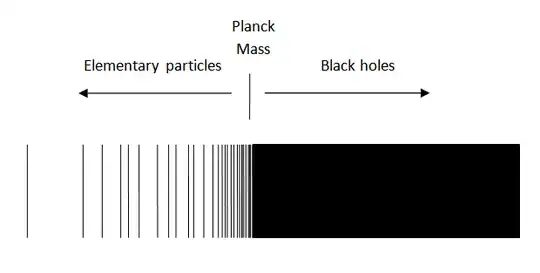There is a popular physics book (similar to The Elegant Universe, but different) (EDIT: a comment suggested this is The Black Hole War, and that sounds right, although I can't reference the exact figure) that I remember addressing the significance of the Planck Mass relative to the idea of elementary particles versus black holes. For now, Wikipedia will have to suffice, which I will reference here:
http://en.wikipedia.org/wiki/Planck_mass
The Planck mass can be derived approximately by setting it as the mass whose Compton wavelength and Schwarzschild radius are equal.
So why does this matter? The argument as I remember in the book goes like this:
Both elementary particles and black holes are "singular" objects. An atom, by comparison, is a collection of elementary particles, with structure to boot. A black hole can have almost any given mass. If a particle falls into a black hole, its mass increases by that amount. If you include massless particles, the permitted mass of black holes is almost a continuum. Not so for elementary particles. They have a certain rest mass (if any), and this rest mass comes from the fundamental properties of the universe.
The Planck Mass, the argument goes, is like the boundary between these two regions of elementary particles and black holes. This book had a very good image illustrating this. Unfortunately I can't find it anywhere online, so I will reproduce it here:

A notable observation is that there are much fewer particles with low rest masses, like the electron. This is consistent with what we know. As particle physics advances, we also produce more high mass particles, like the Higgs. By this line of thinking (which I'm not 100% confident is true), there will be a much higher density of particles at higher masses as they approach the Planck mass. Once you get higher mass than that, you're talking about a valid black hole.
That region, however, is relatively unimportant from a practical perspective because both high mass elementary particles (see again, the Higgs) and low mass black holes are incredibly unstable. Thus, on either side on that divide the particles are particularly short lived. You have to go far right or far left to get something stable.
Allow me to make the obvious argument that the absence of stable particles and black holes at our physical scale is important. Why? Because that means that for the mass ranges from quarks to almost stellar-mass black holes, the universe has no choice but to make complex things, made of many elementary particles, but not collapsed into a black hole. I hope the Anthropic argument is then obvious. We should be thankful that our cells are not commonly intruded by frequently interacting 100s of GeV or TeV particles, as this would not be good for cell chemistry. We can also be thankful that small black holes are not stable... I hope the reason for that is obvious.

 = 2.17651(13)×10−8 kg, (or 21.7651 µg)
= 2.17651(13)×10−8 kg, (or 21.7651 µg) .
.